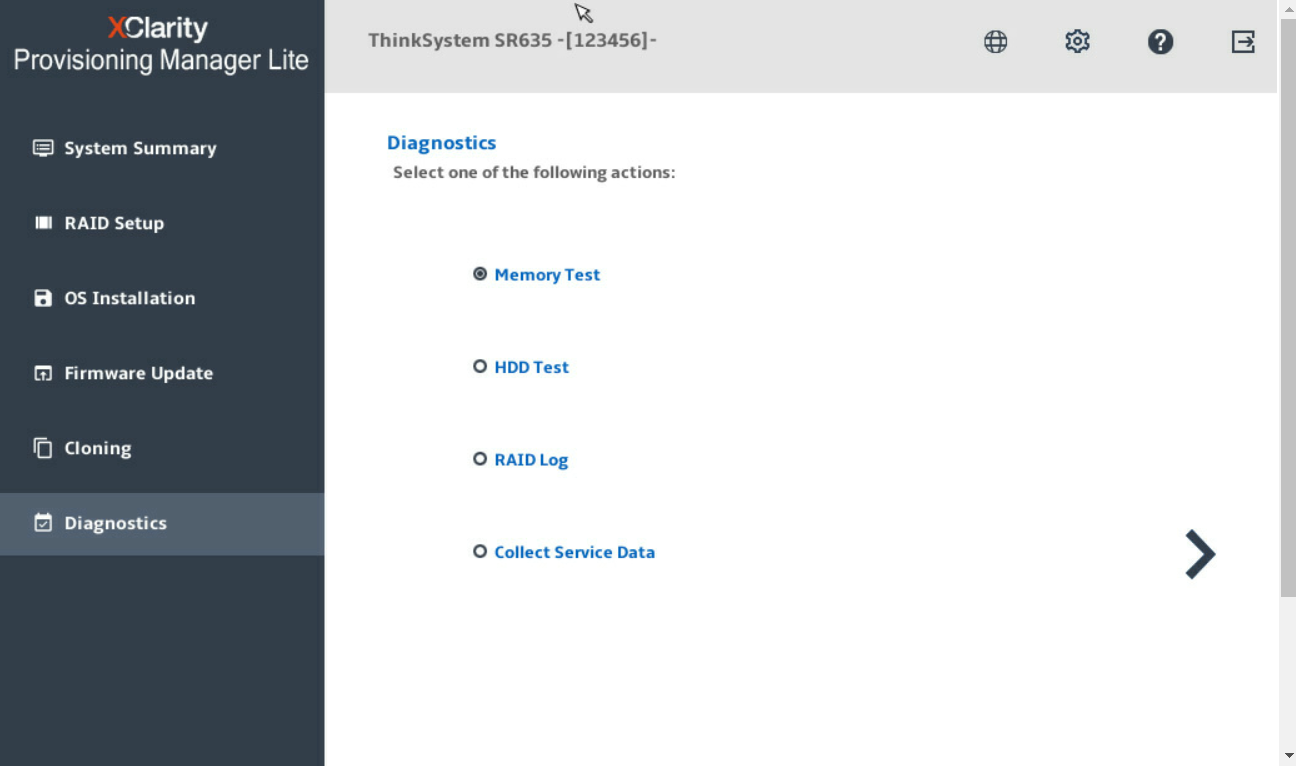Running diagnostics
Memory Test: Run the memory test.
HDD Test: Run the disk drive test.
RAID Log: Collect the logs for the selected RAID adapters.
Collect Service Data: Collect log data from BMC

Running memory test
To save the test result, attach a USB storage drive to the server or connect the server to a shared network. For instructions on connecting to a shared network, refer to Configuring network settings.
Click the Memory Test tab.
- Select one of the following test options, and click Run Test to start testing.
Memory Test Types Function Memory Test Settings Log format Log save location Quick Test Default test type. Select this option to run the WriteRead test pattern only. Support memory.log USB flash drive
Website
Full Test Select this option to runs all test patterns, which takes a long time to finish. Support Advanced Memory Test This option supports the in-depth memory test in all Dual In-line Memory Modules (DIMMs) installed in the Lenovo ThinkSystem server. It also permanently repairs the marginal DIMMs with hard Post Package Repair (PPR) feature during the test, which will reduce memory errors and increase the reliability of the servers. Not support adv_memory.log USB flash drive
NoteFor Quick Test or Full Test:
The mouse pointer is not active during the test process.
After the testing process is completed, the test result will be displayed to show you if the test is passed or failed.
You can press Esc to stop the test.
For Advanced Memory Test:
This option is only available for server installed with AMD EPYC 7XX3 Series processor.
The test time depends on the DIMM configuration.
The system will be restarted when running the test, and a dialog will be displayed on the Memory Test page after the test. You can save the logs.
- To save the test result, click Save after the process is completed.NoteThe test result will be saved in the
memory.log file in the USB storage drive or the shared network folder. Compared with the test result displayed on the interface, the file contains more details.
Running disk drive test
If you want to save the test result, attach a USB storage drive to the server or connect your server to a shared network. For instructions on how to connect to a shared network, refer to Configuring network settings.
Click the to enter the test setting interface.
- Select the test options according to your need, and click Run Test to start testing.Note
Short Self Test is selected as the test type by default.
The mouse pointer is not active during the testing process.
You can press Esc to stop the test.
If you are running test for NVMe SSDs, no matter you select Short Self Test or Long Self Test, the test item only includes the Self-Monitoring, Analysis, and Reporting Technology (SMART) flag status.
- Click Save after the testing process is completed if you want to save the test result.Note
The test result will be saved in an hdd log file in the USB storage drive or the shared network folder. The file includes more details than the test result displayed on the interface.
If two M.2 drives are configured as a RAID array, the drives are not supported in the disk drive test. If you want to use disk drive test function to test the M.2 drives, do not configure them as a RAID array.
Collecting RAID logs
If you want to save the logs, attach a USB storage drive to the server or connect your server to a shared network. For instructions on how to connect to a shared network, refer to Configuring network settings.
Click the to enter the setting interface.
- Select the RAID adapter that you want to collect the logs and click Collect RAID Log to start the collection.NoteThe mouse pointer is not active during the collecting process.
After the collecting process is finished, the summary information for the RAID adapter will be displayed. You can click View Recent Log to see the recent logs of the RAID adapter.
- If you want to save the detailed logs, click Save Detailed Log. The collected logs will be saved in three TXT files in the USB storage drive or the shared network folder. The three TXT files include the following information respectively:
Basic information about the RAID adapter
Firmware logs for troubleshooting
Event logs for the RAID adapter
Collecting Service Data
If you want to save the data, attach a USB storage drive to the server or connect your server to a shared network. For instructions on how to connect to a shared network, refer to Configuring network settings.
Click the Collect Service Data tab to generate and collect data.
Wait for several minutes to finish the collecting process. Then click
 to save the data. The collected data will be saved in the USB storage drive or the shared network folder.
to save the data. The collected data will be saved in the USB storage drive or the shared network folder.